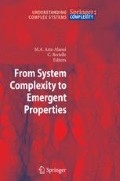Summary
The development of distributed computations and complex systems modelling [11] leads to the creation of innovative algorithms based on interacting virtual entities, specifically for optimisation purposes within complex phenomena. Particule Swarm Optimisation (PSO) and Ant Colony Optimisation (ACO) are two of these algorithms. We propose in this paper a method called Community Swarm Optimisation (CSO). This method is based on more sophisticated entities which are defined by behavioral automata. This algorithm leads to the emergence of the solution by the co-evolution of their behavioral and spatial characteristics. This method is suitable for urban management, in order to improve the understanding of the individual behaviors over the emergent urban organizations.
Access this chapter
Tax calculation will be finalised at checkout
Purchases are for personal use only
Preview
Unable to display preview. Download preview PDF.
References
Benenson, I., Torrens, P.M.: Geosimulation - Automata-based modeling of urban phenomena. Wiley, Chichester (2004)
Bertelle, C., Flouret, M., Jay, V., Olivier, D., Ponty, J.-L.: Genetic algorithms on automata with multiplicities for adaptive agent behaviour in emergent organizations. In: SCI 2001, Orlando, Florida, USA, July 22-25 (2001)
Bonabeau, E., Dorigo, M., Theraulaz, G.: Swam Intelligence, from natural to artificial systems. In: The Santa Fe Institute Studies in the Sciences of Complexity. Oxford University Press, Oxford (1999)
Bourbaki, N.: Elements of Mathematics: General Topology, ch. 5-10. Springer, Heidelberg (1998)
De Castro, L.N., Timmis, J.: Artificial immune system: a new computational approach. Springer, London (2002)
Ghnemat, R., Oqeili, S., Bertelle, C., Duchamp, G.H.E.: Automata-Based Adaptive Behavior for Economic Modelling Using Game Theory. In: Aziz-Alaoui, M.A., Bertelle, C. (eds.) Emergent Properties in Natural and Artificial Dynamical Systems. Springer, Heidelberg (2006)
Ghnemat, R., Bertelle, C., Duchamp, G.H.E.: Adaptive Automata Community Detection and Clustering, a generic methodology. In: Proceedings of World Congress on Engineering 2007, International Conference of Computational Intelligence and Intelligent Systems, London, U.K, July 2-4, pp. 25–30 (2007)
Golan, J.S.: Power algebras over semirings. Kluwer Academic Publishers, Dordrecht (1999)
Goldberg, D.E.: Genetic Algorithms. Addison-Wesley, Reading (1989)
Kennedy, J., Eberhart, R.C.: Particle Swarm Optimization. In: Proceedings of IEEE International Conference on Neural Networks, Perth, Australia, vol. 5(3), pp. 1942–1948. IEEE Service Center, Piscataway (1995)
Le Moigne, J.-L.: La modélisation des systèmes complexes, Dunod (1999)
Reynolds, C.W.: Flocks, Herds and Schools: a distributed behavioral model. Computer Graphics 21(4), 25–34 (1987) (SIGGRAPH 1987 Conference Proceedings)
Schelling, T.C.: Dynamic Models of Segregation. Journal of Mathematical Sociology 1, 143–186 (1971)
Schützenberger, M.P.: On the definition of a family of automata. Information and Control 4, 245–270 (1961)
Schweitzer, F.: Brownian Agents and Active Particles. Springer, Heidelberg (2003)
Stanley, R.P.: Enumerative combinatorics. Cambridge University Press, Cambridge (1999)
Weiss, G. (ed.): Multiagent Systems. MIT Press, Cambridge (1999)
Xiao, N.: Geographic optimization using evolutionary algorithms. In: 8th International Conference on GeoComputation, University of Michigan, USA (2005)
Author information
Authors and Affiliations
Editor information
Editors and Affiliations
Rights and permissions
Copyright information
© 2009 Springer-Verlag Berlin Heidelberg
About this chapter
Cite this chapter
Ghnemat, R., Bertelle, C., Duchamp, G.H.E. (2009). Community Swarm Optimization. In: Aziz-Alaoui, M.A., Bertelle, C. (eds) From System Complexity to Emergent Properties. Understanding Complex Systems. Springer, Berlin, Heidelberg. https://doi.org/10.1007/978-3-642-02199-2_9
Download citation
DOI: https://doi.org/10.1007/978-3-642-02199-2_9
Publisher Name: Springer, Berlin, Heidelberg
Print ISBN: 978-3-642-02198-5
Online ISBN: 978-3-642-02199-2
eBook Packages: Physics and AstronomyPhysics and Astronomy (R0)

